Tom Gunter
Datasets, Documents, and Repetitions: The Practicalities of Unequal Data Quality
Mar 10, 2025Abstract:Data filtering has become a powerful tool for improving model performance while reducing computational cost. However, as large language model compute budgets continue to grow, the limited data volume provided by heavily filtered and deduplicated datasets will become a practical constraint. In efforts to better understand how to proceed, we study model performance at various compute budgets and across multiple pre-training datasets created through data filtering and deduplication. We find that, given appropriate modifications to the training recipe, repeating existing aggressively filtered datasets for up to ten epochs can outperform training on the ten times larger superset for a single epoch across multiple compute budget orders of magnitude. While this finding relies on repeating the dataset for many epochs, we also investigate repeats within these datasets at the document level. We find that not all documents within a dataset are equal, and we can create better datasets relative to a token budget by explicitly manipulating the counts of individual documents. We conclude by arguing that even as large language models scale, data filtering remains an important direction of research.
Apple Intelligence Foundation Language Models
Jul 29, 2024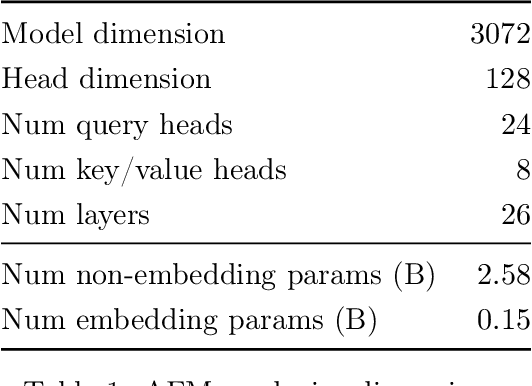
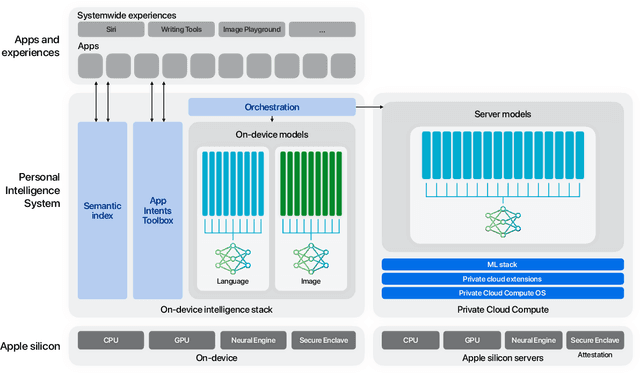

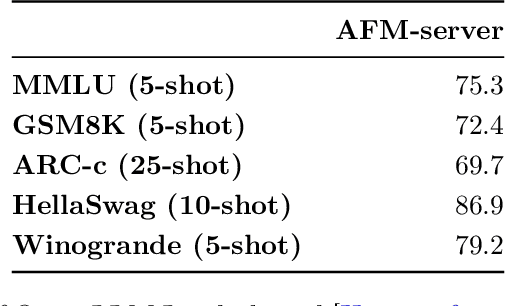
Abstract:We present foundation language models developed to power Apple Intelligence features, including a ~3 billion parameter model designed to run efficiently on devices and a large server-based language model designed for Private Cloud Compute. These models are designed to perform a wide range of tasks efficiently, accurately, and responsibly. This report describes the model architecture, the data used to train the model, the training process, how the models are optimized for inference, and the evaluation results. We highlight our focus on Responsible AI and how the principles are applied throughout the model development.
Large Language Model-guided Document Selection
Jun 07, 2024



Abstract:Large Language Model (LLM) pre-training exhausts an ever growing compute budget, yet recent research has demonstrated that careful document selection enables comparable model quality with only a fraction of the FLOPs. Inspired by efforts suggesting that domain-specific training document selection is in fact an interpretable process [Gunasekar et al., 2023], as well as research showing that instruction-finetuned LLMs are adept zero-shot data labelers [Gilardi et al.,2023], we explore a promising direction for scalable general-domain document selection; employing a prompted LLM as a document grader, we distill quality labels into a classifier model, which is applied at scale to a large, and already heavily-filtered, web-crawl-derived corpus autonomously. Following the guidance of this classifier, we drop 75% of the corpus and train LLMs on the remaining data. Results across multiple benchmarks show that: 1. Filtering allows us to quality-match a model trained on the full corpus across diverse benchmarks with at most 70% of the FLOPs, 2. More capable LLM labelers and classifier models lead to better results that are less sensitive to the labeler's prompt, 3. In-context learning helps to boost the performance of less-capable labeling models. In all cases we use open-source datasets, models, recipes, and evaluation frameworks, so that results can be reproduced by the community.
Revisiting MoE and Dense Speed-Accuracy Comparisons for LLM Training
May 23, 2024



Abstract:Mixture-of-Experts (MoE) enjoys performance gain by increasing model capacity while keeping computation cost constant. When comparing MoE to dense models, prior work typically adopt the following setting: 1) use FLOPs or activated parameters as a measure of model complexity; 2) train all models to the same number of tokens. We argue that this setting favors MoE as FLOPs and activated parameters do not accurately measure the communication overhead in sparse layers, leading to a larger actual training budget for MoE. In this work, we revisit the settings by adopting step time as a more accurate measure of model complexity, and by determining the total compute budget under the Chinchilla compute-optimal settings. To efficiently run MoE on modern accelerators, we adopt a 3D sharding method that keeps the dense-to-MoE step time increase within a healthy range. We evaluate MoE and dense LLMs on a set of nine 0-shot and two 1-shot English tasks, as well as MMLU 5-shot and GSM8K 8-shot across three model scales at 6.4B, 12.6B, and 29.6B. Experimental results show that even under these settings, MoE consistently outperform dense LLMs on the speed-accuracy trade-off curve with meaningful gaps. Our full model implementation and sharding strategy will be released at~\url{https://github.com/apple/axlearn}
MM1: Methods, Analysis & Insights from Multimodal LLM Pre-training
Mar 22, 2024



Abstract:In this work, we discuss building performant Multimodal Large Language Models (MLLMs). In particular, we study the importance of various architecture components and data choices. Through careful and comprehensive ablations of the image encoder, the vision language connector, and various pre-training data choices, we identified several crucial design lessons. For example, we demonstrate that for large-scale multimodal pre-training using a careful mix of image-caption, interleaved image-text, and text-only data is crucial for achieving state-of-the-art (SOTA) few-shot results across multiple benchmarks, compared to other published pre-training results. Further, we show that the image encoder together with image resolution and the image token count has substantial impact, while the vision-language connector design is of comparatively negligible importance. By scaling up the presented recipe, we build MM1, a family of multimodal models up to 30B parameters, including both dense models and mixture-of-experts (MoE) variants, that are SOTA in pre-training metrics and achieve competitive performance after supervised fine-tuning on a range of established multimodal benchmarks. Thanks to large-scale pre-training, MM1 enjoys appealing properties such as enhanced in-context learning, and multi-image reasoning, enabling few-shot chain-of-thought prompting.
Mobile V-MoEs: Scaling Down Vision Transformers via Sparse Mixture-of-Experts
Sep 08, 2023



Abstract:Sparse Mixture-of-Experts models (MoEs) have recently gained popularity due to their ability to decouple model size from inference efficiency by only activating a small subset of the model parameters for any given input token. As such, sparse MoEs have enabled unprecedented scalability, resulting in tremendous successes across domains such as natural language processing and computer vision. In this work, we instead explore the use of sparse MoEs to scale-down Vision Transformers (ViTs) to make them more attractive for resource-constrained vision applications. To this end, we propose a simplified and mobile-friendly MoE design where entire images rather than individual patches are routed to the experts. We also propose a stable MoE training procedure that uses super-class information to guide the router. We empirically show that our sparse Mobile Vision MoEs (V-MoEs) can achieve a better trade-off between performance and efficiency than the corresponding dense ViTs. For example, for the ViT-Tiny model, our Mobile V-MoE outperforms its dense counterpart by 3.39% on ImageNet-1k. For an even smaller ViT variant with only 54M FLOPs inference cost, our MoE achieves an improvement of 4.66%.
STAIR: Learning Sparse Text and Image Representation in Grounded Tokens
Feb 08, 2023Abstract:Image and text retrieval is one of the foundational tasks in the vision and language domain with multiple real-world applications. State-of-the-art approaches, e.g. CLIP, ALIGN, represent images and texts as dense embeddings and calculate the similarity in the dense embedding space as the matching score. On the other hand, sparse semantic features like bag-of-words models are more interpretable, but believed to suffer from inferior accuracy than dense representations. In this work, we show that it is possible to build a sparse semantic representation that is as powerful as, or even better than, dense presentations. We extend the CLIP model and build a sparse text and image representation (STAIR), where the image and text are mapped to a sparse token space. Each token in the space is a (sub-)word in the vocabulary, which is not only interpretable but also easy to integrate with existing information retrieval systems. STAIR model significantly outperforms a CLIP model with +$4.9\%$ and +$4.3\%$ absolute Recall@1 improvement on COCO-5k text$\rightarrow$image and image$\rightarrow$text retrieval respectively. It also achieved better performance on both of ImageNet zero-shot and linear probing compared to CLIP.
Self Supervision Does Not Help Natural Language Supervision at Scale
Jan 20, 2023



Abstract:Self supervision and natural language supervision have emerged as two exciting ways to train general purpose image encoders which excel at a variety of downstream tasks. Recent works such as M3AE and SLIP have suggested that these approaches can be effectively combined, but most notably their results use small pre-training datasets (<50M samples) and don't effectively reflect the large-scale regime (>100M examples) that is commonly used for these approaches. Here we investigate whether a similar approach can be effective when trained with a much larger amount of data. We find that a combination of two state of the art approaches: masked auto-encoders, MAE and contrastive language image pre-training, CLIP provides a benefit over CLIP when trained on a corpus of 11.3M image-text pairs, but little to no benefit (as evaluated on a suite of common vision tasks) over CLIP when trained on a large corpus of 1.4B images. Our work provides some much needed clarity into the effectiveness (or lack thereof) of self supervision for large-scale image-text training.
Unknowable Manipulators: Social Network Curator Algorithms
Jan 17, 2017Abstract:For a social networking service to acquire and retain users, it must find ways to keep them engaged. By accurately gauging their preferences, it is able to serve them with the subset of available content that maximises revenue for the site. Without the constraints of an appropriate regulatory framework, we argue that a sufficiently sophisticated curator algorithm tasked with performing this process may choose to explore curation strategies that are detrimental to users. In particular, we suggest that such an algorithm is capable of learning to manipulate its users, for several qualitative reasons: 1. Access to vast quantities of user data combined with ongoing breakthroughs in the field of machine learning are leading to powerful but uninterpretable strategies for decision making at scale. 2. The availability of an effective feedback mechanism for assessing the short and long term user responses to curation strategies. 3. Techniques from reinforcement learning have allowed machines to learn automated and highly successful strategies at an abstract level, often resulting in non-intuitive yet nonetheless highly appropriate action selection. In this work, we consider the form that these strategies for user manipulation might take and scrutinise the role that regulation should play in the design of such systems.
Blitzkriging: Kronecker-structured Stochastic Gaussian Processes
Oct 31, 2015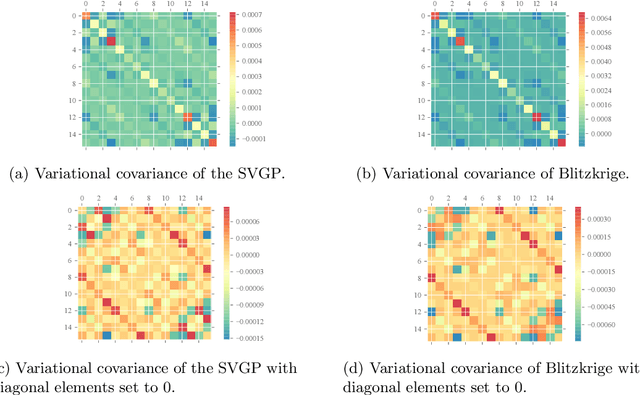

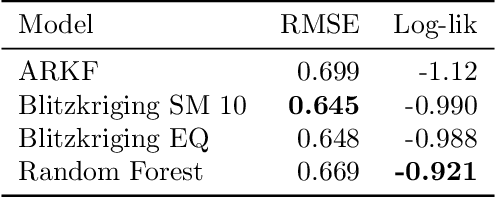
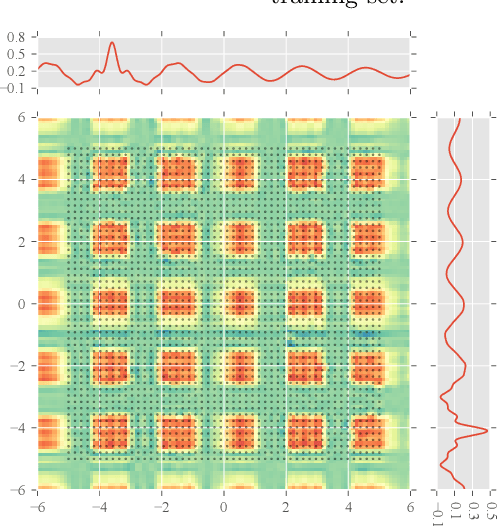
Abstract:We present Blitzkriging, a new approach to fast inference for Gaussian processes, applicable to regression, optimisation and classification. State-of-the-art (stochastic) inference for Gaussian processes on very large datasets scales cubically in the number of 'inducing inputs', variables introduced to factorise the model. Blitzkriging shares state-of-the-art scaling with data, but reduces the scaling in the number of inducing points to approximately linear. Further, in contrast to other methods, Blitzkriging: does not force the data to conform to any particular structure (including grid-like); reduces reliance on error-prone optimisation of inducing point locations; and is able to learn rich (covariance) structure from the data. We demonstrate the benefits of our approach on real data in regression, time-series prediction and signal-interpolation experiments.
 Add to Chrome
Add to Chrome Add to Firefox
Add to Firefox Add to Edge
Add to Edge